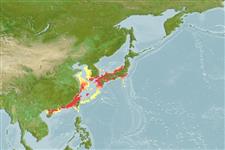Common names from other countries
Environment: milieu / climate zone / depth range / distribution range
Ökologie
seewasser riff-verbunden; tiefenbereich 1 - 55 m (Ref. 89707). Tropical; 39°N - 20°N, 109°E - 143°E (Ref. 5222)
Northwest Pacific: southern China, Taiwan, East China Sea, Korea, and southern Japan (Kyushu to about 38°N on both coasts of Honshu). Reported specimen from Viet Nam may be Epinephelus fasciatomaculosus and records from the Philippines and India are unsubstantiated.
Length at first maturity / Size / Gewicht / Alter
Maturity: Lm ?, range 23 - ? cm
Max length : 58.0 cm TL Männchen/unbestimmt; (Ref. 89707); common length : 30.0 cm TL Männchen/unbestimmt; (Ref. 2852); max. veröff. Gewicht: 2.5 kg (Ref. 40637)
Rückenflossenstacheln (insgesamt): 11; Rückenflossenweichstrahlen (insgesamt): 15-17; Afterflossenstacheln 3; Afterflossenweichstrahlen: 8. Distinguished by the following characteristics: head and body pale brownish grey, covered with small red, orange or gold spots except on ventral side; 6 faint oblique dark bars on body; dark brown blotch on body at base of the 3 dorsal fin spines; dorsal fin margin yellow or orange; row of dusky yellow or orange spots along middle of the spinous dorsal fin and another row along the base of the fin; faint red or orange spots at caudal and anal fins; body depth less than head length, 2.7-3.2 times in SL; head length 2.3-2.6 times in SL; preopercle with enlarged serrae at angle; upper edge of operculum straight; subequal posterior and anterior nostril; maxilla reaching about to vertical at rear edge of eye; two rows of teeth at midside of lower jaw; pelvic fins not reaching anus; caudal fin rounded; lateral body scales ctenoid, with auxiliary in adults (Ref. 089707).
Rock-reef species inhabiting depths to at least 55 m. Juveniles are often found shallower than 10 m (Ref. 089707). A highly prized food fish usually caught by hand-lining over rock strata. Found in Hong Kong live fish markets (Ref. 27253).
Heemstra, P.C. and J.E. Randall, 1993. FAO Species Catalogue. Vol. 16. Groupers of the world (family Serranidae, subfamily Epinephelinae). An annotated and illustrated catalogue of the grouper, rockcod, hind, coral grouper and lyretail species known to date. Rome: FAO. FAO Fish. Synop. 125(16):382 p. (Ref. 5222)
IUCN Rote Liste Status (Ref. 130435)
CITES (Ref. 128078)
Not Evaluated
Bedrohung für Menschen
Harmless
Nutzung durch Menschen
Fischereien: weniger kommerziell; Aquakultur: kommerziell
Mehr Information
ReferenzenAquakulturAquakultur ProfilZuchtlinienGenetikElectrophoresesVererbbarkeitKrankheitenVerarbeitungMass conversion
Tools
Zusatzinformationen
Download XML
Internet Quellen
Estimates based on models
Preferred temperature (Ref.
115969): 16 - 25.5, mean 20.6 (based on 178 cells).
Phylogenetic diversity index (Ref.
82804): PD
50 = 0.5000 [Uniqueness, from 0.5 = low to 2.0 = high].
Bayesian length-weight: a=0.01445 (0.00751 - 0.02781), b=3.06 (2.90 - 3.22), in cm Total Length, based on LWR estimates for this species & Genus-body shape (Ref.
93245).
Trophic level (Ref.
69278): 4.0 ±0.65 se; based on food items.
Widerstandsfähigkeit (Ref.
120179): mittel, Verdopplung der Population dauert 1,4 - 4,4 Jahre. (Assuming tm=2).
Fishing Vulnerability (Ref.
59153): Moderate vulnerability (43 of 100).
